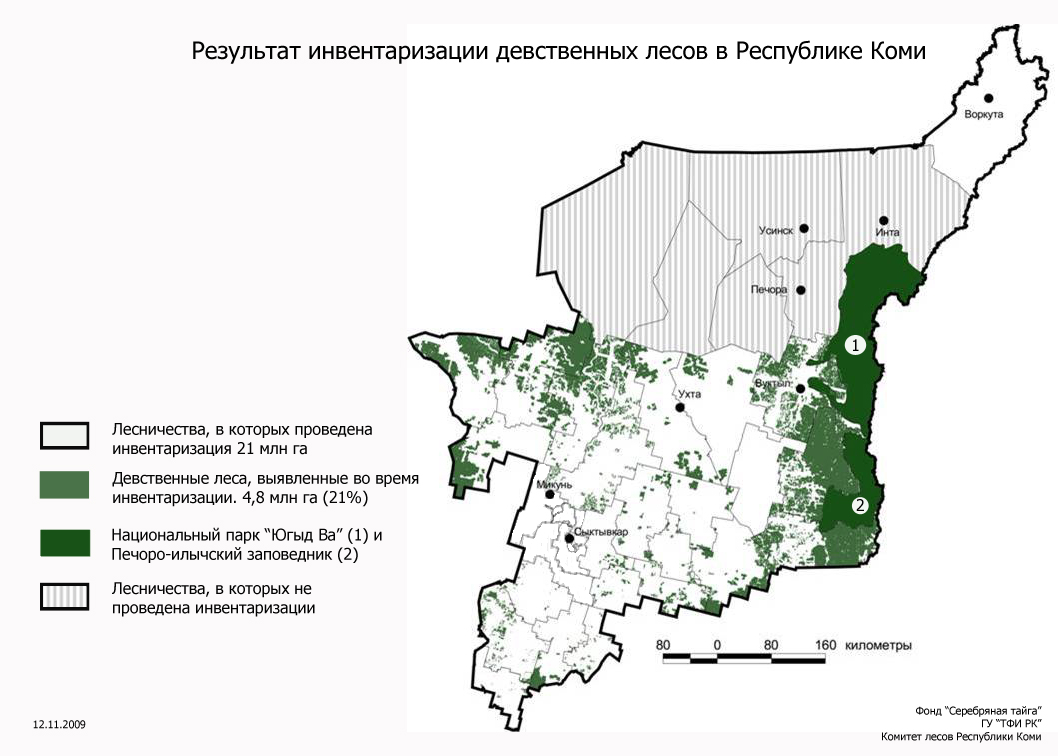«High Conservation Value Forests» project
Pristine forest is the natural forest, which was not significantly affected by the economic and anthropogenic factors (clear cuttings), and has been changed over many generations of the forest forming wood species only under the influence of the natural processes.
All pristine forests are divided into three categories according to their size:
- massives – pristine forests areas of more than 50 thousand ha,
- fragments – pristine forests ranging in size from several quarters to 20 thousand ha,
- plots – separate divisions or quarters of pristine forests.
Large massives of pristine forests are of particular value, as they present the large low-disturbed forest landscapes, where viable populations of the most, if not all, biological species represented on this territory are able to exist in their natural state. Such massives are also called LLFT (large low-disturbed forest territories). According to the Russian National FSC standard put into force in November, 2008, such forest massives fall into the category of High Conservations Value Forest (HCVF 2) and require special attention for the long-term conservation of their ecological value.
The Komi Republic is one of the last regions in Europe, where the pristine forests are still preserved. Their largest massives are situated in the eastern part of the republic adjacent to the Ural mountain range. At the present time they are protected by the state on the territory of the Yugyd-Va National park and Pechora-Ilych Reserve and are included in the List of UNESCO World Cultural Heritage Sites. There are not so many large massives of the pristine forests left on the residual territory of Komi. They have been preserved in the east and north-west of the republic. By the present moment pristine forests in the central and southern part of the region are preserved only as small highly fragmented areas.
“The procedure of the special surveys’ carrying out for marking of the special protection forest areas, as well as pristine forests situated on the territory of the Komi Republic” was developed in Komi. This methodology has been approved by the State Forestry Service of the Komi Republic. During the period from 1998 till 2006 the representatives of the Northern State Forest Inventory Enterprise conducted the work on discovery of the pristine forests situated on the territory of the republic. The results of this work showed that the area occupied by the pristine forests in the Komi Republic is 4,8 million ha (which is 23% of the total area of the territory) (map 1). Besides, there are five pristine forests massives which have been preserved in the Komi Republic until the present time (in the Koygorodok region – Koygorodok massive (map 2); in the Udora region – Pyssa, Karpogory, Timan, and Verkhnevashkino massives (map 3)).
Today the value of the pristine forests is obvious and generally accepted. They present the forest territories, which can provide conservation of the natural dynamics and biodiversity of the taiga forests. Viable populations of the biological species represented on this territory are able to exist there in the natural state. The pristine forests ensure conservation of the biodiversity at the landscape, ecosystem, species, population and genetic levels, including plenty of rare living organisms and the organisms included in the Red Books of different levels and related to the typical original forests of the taiga zone.
The natural succession dynamics of the taiga forests is preserved on the territory of the pristine forests. The types of the forest communities correspond to the ecological niche which they occupy. The ecological structure and dynamics of different scales is preserved in the communities. Populations of the most types of living organisms are sustainable and can exist for an indefinitely long period of time.
Besides, the pristine forest is the best performer of the stabilizing ecological functions, namely, water protecting, water regulating, and environment-forming ones.
With a decrease of the pristine forests rate these functions start to weaken, many species of living organisms disappear, and ecological sustainability of the forest territory gets broken.

